Fresh-to-Market Philadelphia Tea Table Sells for $1,895,000
January 31st, 2015
|
The 1755-57 Potter-Crouch-Jordan family Philadelphia mahogany tea table, 29" high, top 37 3/8" inches in diameter, sold for $1,895,000 (est. $500,000/2,000,000).
A group of Sons of Liberty toasts found in the papers of William Russell (1748-1784), a schoolteacher and early member of the Sons of Liberty and a Boston Tea Party participant, sold for $15,000 (est. $20,000/30,000). The toasts were written on the fourth anniversary of Boston’s Stamp Act Riot, a defiant salute to American liberty.
The Gazette of the United States, New York, October 7, 1789, printed President George Washington’s first Thanksgiving Proclamation on page one (enhanced in photo). It sold for $36,250 (est. $15,000/30,000).
The earliest obtainable printing of the Bill of Rights in the Gazette of the United States, New York, October 3, 1789, (enhanced in photo) sold for $43,750 (est. $30,000/60,000).
Pigtail, asheet metal brass and wire mobile by Alexander Calder (1898-1976), incised “CA” on base, 5½" x 7¼" x 12", sold for $365,000 (est. $50,000/100,000).
Spotted Orb and Pyramids, 1956, gouache on paper, 29½" x 41¼", by Alexander Calder (1898-1976) sold for $78,750 (est. $20,000/40,000).
|
Keno Auctions, New York City
Photos courtesy Keno Auctions
On January 31, after most of the Americana collectors had left New York City, Leigh Keno sold the most
expensive lot of American furniture offered during Americana Week. The previously unknown and unpublished Potter-Crouch-Jordan family Philadelphia mahogany tea table that descended in the family of the original owners for 250 years sold to a special client on the phone with Keno for $1,895,000 (est. $500,000/2,000,000). Keno called this sale a “boutique auction”—just 13 lots offered live and on line through LiveAuctioneers from a small catalog that came out the day before. It was held at his 127 East 69th Street townhouse.
The discovery of the tea table was serendipitous. A photograph came over the transom to Keno last summer, and he got in his car and went after it. He found a rococo Philadelphia tilt-top tea table in untouched condition in the possession of a bearded fellow in Maine and convinced him that he could get him the best price, but it would take patience. Keno delivered.
The bearded fellow, pictured in the front of the sale catalog, came to the sale with 30 of his relatives to see the table sell on the phone. It was the only million-dollar lot sold during Americana Week 2015. It became number 33 on the M.A.D. list of million-dollar pieces of American furniture. It was the first addition to the list since January 2013, when Sotheby’s sold Samuel Talcott’s cherrywood desk and bookcase for $1,082,500 to Keno and Christie’s sold a mahogany bureau table from the shop of John Townsend, signed by his younger brother Jonathan, for $2,210,500.
Keno spent six months having the tea table documented. The story unfolded slowly. Researcher Amy Coes of Philadelphia traced its ownership to Edward Crouch (1764-1827) and his wife, Margaret Potter (1775-1797), of Dauphin County, Pennsylvania. The couple had inherited it from one of their sets of parents. Margaret was the daughter of Major General James Potter (1729-1789), a Revolutionary war patriot and wealthy Pennsylvania landowner, and his second wife, Mary Patterson (1739-1791). They married in 1765, but Keno believes Potter already owned the table, having bought it in 1755, when he married his first wife, Elizabeth Cathcart, who died in 1764. But it could have been made for Colonel James Crouch (c. 1728-1794), another Pennsylvania landowner, and his wife, Hannah Brown (1727-1787), when they married in 1757 to furnish their house, Walnut Hill, in Dauphin County.
The table, made in the 1750s, descended in the family in a remarkable state of preservation. It was never refinished, waxed, or varnished, only dusted over the years. The luck of the untouched finish seemed even more remarkable when Keno discovered the mate to this table in storage at the Metropolitan Museum of Art; that one was refinished. The carving on the legs and on the pedestal (including the unusual twist at the top of the pedestal) is the same, and so are the exceptionally large scallops on its oversize top.
Who made these tables? Who carved them? Keno was determined to find out. Furniture historian Alan Miller has attributed the carving to an as-yet-unidentified carver, whom he’s nicknamed “Spike” because of his spiky naturalistic carving. Spike had been identified as the carver of the Gratz family dressing table at Winterthur, the Lawrence-Palmer high chest at the Metropolitan Museum of Art, and the Wistar-Sharples desk-and-bookcase at the Philadelphia Museum of Art. According to Keno’s catalog, Spike’s use of C-scrolls ending in leafage, with gouge cuts near the end of the leaf tips and veining, makes his carving look spiky.
The table’s single-board mahogany top is larger than the top of most Philadelphia tea tables. It measures 37 3/8" in diameter. Most Philadelphia tea tables average 32" in diameter, and they rarely exceed 34". Its deeply carved piecrust edge is shaped into eight repeating 5" broad scallops alternating between 9" double-peaked cyma curve passages. The table tilts and turns on its box, called a “birdcage,” supported by turned balusters that echo the shape of the baluster on its shaft. Its tripod base and the bottom half of the baluster are carved with rococo scrolls, cabochons, and leafage, and the spiral fluting above the gadrooned canopy above its vasiform shaft is unusual. The rococo carving on the bottom of the baluster and on the legs and C-scrolls under the legs is typical of Philadelphia carving of the 1750s, early in the rococo style.
What shop made the table was a question still being discussed at the pop-up cocktail party Keno gave on Sunday, January 25, that celebrated the discovery of the table. A few days later, a raking light revealed the chalk signature of Henry Cliffton. It matched the Cliffton signature and date “1753” on a high chest at Colonial Williamsburg, said to be the earliest signed piece of American rococo furniture.
The table, fresh to market, with a maker and carver ascribed and a family history, is an auctioneer’s dream. The stars were aligned. The bidders and underbidders materialized (three of them, two on the phone and the underbidder, Seth Kaller, in the salesroom) when auctioneer John Nye took up the gavel, volunteering his services to his friend Leigh Keno.
As previously mentioned, the Keno Auctions winter sale was a small one. It was held in two sessions on a Saturday afternoon. Nine lots of Americana were in session one, scheduled for noon, and there were four lots of modern art, scheduled for 2 p.m. Bidding on the first lot, the Potter-Crouch-Jordan family table, did not get underway until 12: 22 p.m., carried live with video on LiveAuctioneers.
It was 12:30 by the time Keno told the assembled crowd and the on-line audience about the table’s discovery and the discovery of its maker and carver and the fact that Christie’s John Hays was in the audience (he had sold the Fisher-Fox tea table with carving attributed to the Garvan carver for $6,761,000 in October 2007). John Nye read the conditions of sale and opened the bidding at $450,000. Bidding moved quickly, with Seth Kaller bidding for a client from the rear of the room and Keno on the phone with his client. A phone bidder with Jack O’Brien bid $850,000, but from then on it was Keno on the phone and Seth Kaller bidding for his client. Nye dropped his gavel at $1,575,000. The buyer’s premium (25% up to $100,000, 20% in excess of $100,000 up to $2 million) brought the price to $1,895,000.
The remaining eight lots of historic documents followed. One of them did not find a buyer. The only known copy of the Thomas Holme “Map of the Improved Part of the Province of Pennsilvania [sic] in America” containing the three counties of Chester, Philadelphia, and Bucks, published in London, 1687, failed to sell. It carried a $200,000/300,000 estimate. Modern color makes it handsome, but antiquarians may prefer it uncolored, as it was when it was printed.
All the rest of the historic material sold. There were two rare 1789 issues of the New York Gazette of the United States. The one with the printing of the Bill of Rights, October 3, 1789, misprinted “October 1” and corrected by hand, sold for $43,750 (est. $30,000/60,000). There has never been an October 2 copy for sale, though one is known. The other historic copy of the New York Gazette, dated October 7, 1789, has Washington’s first presidential Thanksgiving Proclamation on its first page. It sold for $36,250 (est. $15,000/30,000). A unique 1769 Sons of Liberty document capturing patriotic toasts for the fourth anniversary of Boston’s Stamp Act Riot sold for $15,000 (est. $20,000/30,000). Other lots sold under estimates or not much above estimates. Benjamin Franklin’s address to the Reformed Dutch Church in support of the abolition of slavery, printed in the Gazette, sold for $4375 (est. $4000/8000), and a 1682 William Penn deed sold for $7625 (est. $10,000/20,000).
 The sale then recessed until 2 p.m. When it reconvened, four lots of contemporary art were offered. A gouache on paper, 29½" x 41¼", signed “Calder 56” by Alexander Calder, sold for $78,750. A small sheet metal brass and wire 1968 standing mobile, Pigtail, by Calder, marked “CA,” fetched $365,000, well over its $50,000/100,000 estimate.
The sale then recessed until 2 p.m. When it reconvened, four lots of contemporary art were offered. A gouache on paper, 29½" x 41¼", signed “Calder 56” by Alexander Calder, sold for $78,750. A small sheet metal brass and wire 1968 standing mobile, Pigtail, by Calder, marked “CA,” fetched $365,000, well over its $50,000/100,000 estimate.
The featured work by Ruth Asawa, untitled (but numbered by the artist “S. 621”), ahanging six-lobed multilayered wire sculpture from the estate of Ruth Asawa and John Kerr, sold in the room to New York and Michigan dealer Jonathan Boos for $965,000 (est. $150,000/ 250,000). It had been videotaped in Robert Snyder’s 1973 documentary Ruth Asawa: Of Forms and Growth, in which she describes her labor-intensive process of creating her three-dimensional wire drawings in air.
“My approach for the winter sale was that the rococo table produced by Henry Cliffton circa 1755 was no less avant-garde in its day than the 1969 standing mobile by Philadelphia-born Calder or the 1973 hanging sculpture by California-born Asawa,” said Keno after the sale. “I want to have more small sales of masterworks from all ages.”
The sale of 12 of the 13 lots brought a total of $3,456,500, topping its wide-ranging presale estimates $1,045,000/2,890,000 (figured without buyers’ premiums).
For more information about the sale, contact Keno Auctions at (212) 734-2381 or see the Web site (www.kenoauctions.com).
Originally published in the April 2015 issue of Maine Antique Digest. © 2015 Maine Antique Digest






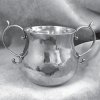
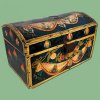




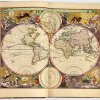

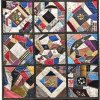



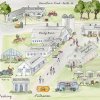

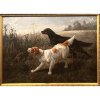






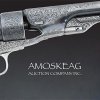

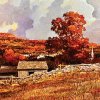
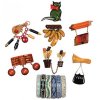
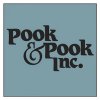


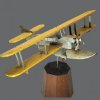







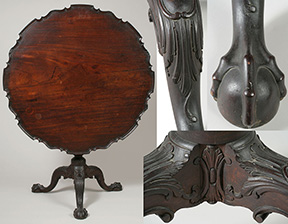
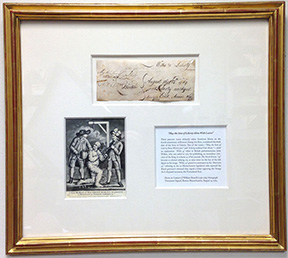
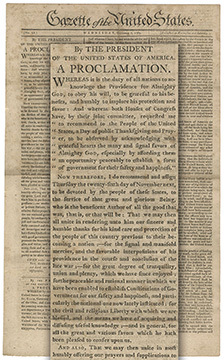
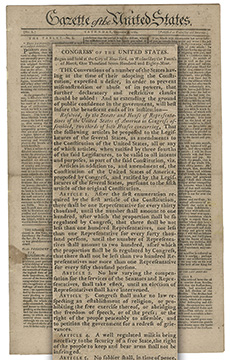
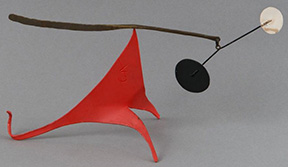
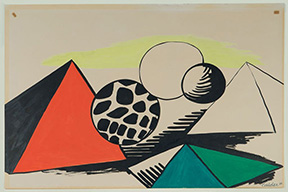
 Numbered “S. 621” by the artist, a hanging six-lobed multilayered 77" x 16½" x 16½" brass and copper wire sculpture by Ruth Asawa (1926-2013) with interlocking forms including a sphere in the third lobe, circa 1973, sold for $965,000 (est. $150,000/250,000).
Numbered “S. 621” by the artist, a hanging six-lobed multilayered 77" x 16½" x 16½" brass and copper wire sculpture by Ruth Asawa (1926-2013) with interlocking forms including a sphere in the third lobe, circa 1973, sold for $965,000 (est. $150,000/250,000).




